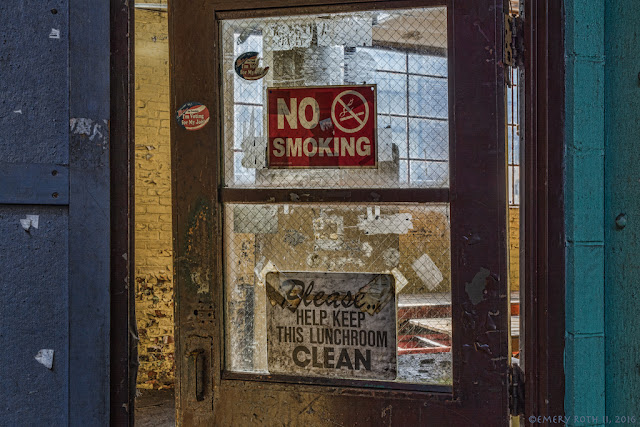PHOTOGRAPHER’S JOURNAL: Factories cluster along a rail corridor like swine at a food trough, and bridges carry everything from people to cranes to utility conduits over the tracks. There were many bridges, but there was only one road crossing the mill site. Sunset illuminates the road from the riverside up to Liberty Street. The old rolling mill was in the dark building on the left, though for modern workers it was the flat wire mill. The rod mill is on the right and stretches an equal distance behind me as in front of me. This is a universal landscape of industrial America, the landscape that Gropius idealized and aesthetized.
A bridge was built here sometime between 1890 and 1895. There is a trick to this bridge, and for a long time it puzzled me. (text continued below)
The bridge does not end at the factory wall but continues across the bay to an attic-like space that runs above much of the length of the rod mill. Like this bridge, the bridge that crossed the tracks in 1895 reached well beyond the rail corridor to a narrow work shed which the map labels, “Burner Shop,” of "Wallace & Sons Manuf’rs of Brass and Copper Goods.” Men worked there on edging lathes, and in a press room. Was this the bridge that carried the finished burners across the tracks to the “Lamp Depart" and “Stock R’m” at about the time Edison and Tezla fought the battle of the currents in White City? (text continued below)
After White City was done glistening, factories became even more like big machines. The dark “dormer,” which casts it shadow beside the old rolling mill, is really the stub end of a missing bridge over which rode a monorail crane. The old crane is still parked inside the stub of the bridge (shown here: http://rothphotos.blogspot.com/2014/10/parked.html), and the track still runs down the length of the attic and turns right at the end of the rod mill. Once, it crossed the yard to the casting house, turned left and crossed back over the track, connecting finally to what used to be the rolling mill built by Ansonia Brass & Copper, the company started here by Anson Phelps. One can see both bridges for the first time in the 1921, aerial map of Ansonia (https://www.loc.gov/resource/g3784a.pm000770/). The second monorail bridge is the covered bridge with the skylight and roof vents. Behind it is the two-story bridge of the Farrel sand elevator.








